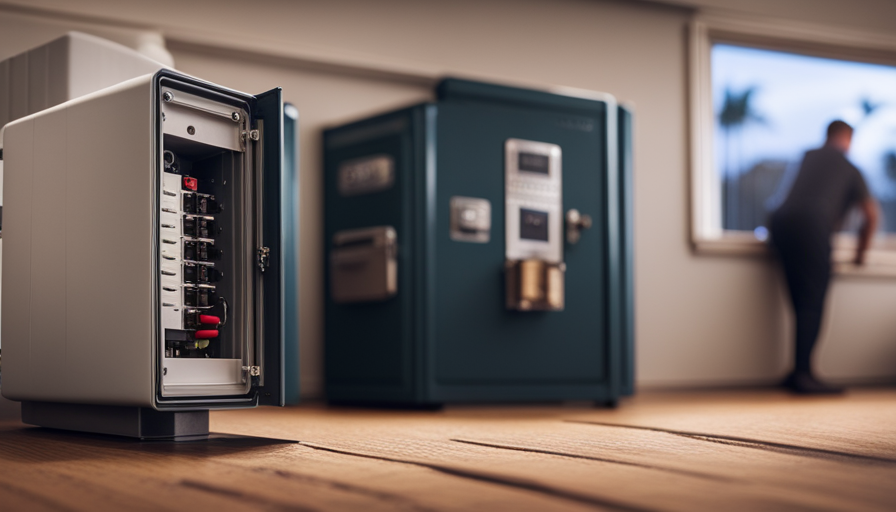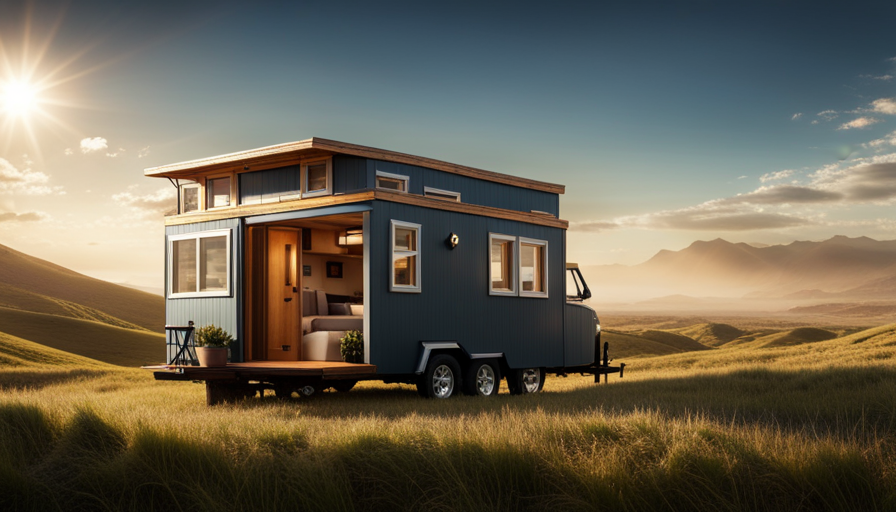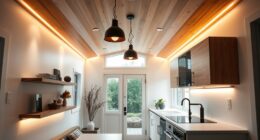Explore the exciting world of tiny house living! This article will delve into the fascinating realm of electrical setups for these small homes.
Just like a river flows through its banks, power surges through the veins of your tiny home. But before you can harness that energy, you must first determine how many amps your tiny abode requires.
Understanding your power needs is crucial in ensuring a seamless and efficient electrical system. From lighting to appliances, every wattage counts when designing your electrical layout. By adhering to electrical codes and regulations, you can guarantee safety and compliance with local authorities.
Planning your electrical system design is equally important. Selecting the right electrical panel, installing proper wiring and circuits, and incorporating ground fault circuit interrupters (GFCIs) are integral steps in creating a reliable and resilient power network.
Remember to regularly maintain and inspect your electrical system for optimal performance. And if the technicalities overwhelm you, don’t hesitate to seek professional help.
So come along as we embark on this enlightening journey towards an efficient and sustainable tiny home lifestyle!
Key Takeaways
- Determining power needs and calculating amps is crucial for designing the electrical system of a tiny house.
- Hiring a licensed electrician and understanding electrical codes and regulations are important for safety and compliance.
- Choosing the right electrical panel with sufficient capacity is essential to meet power needs and prevent overloads.
- Regular maintenance and inspections of the electrical system are necessary for safety and functionality in a tiny house.
Determine Your Power Needs
Figuring out your power needs is like shining a flashlight into the dark corners of your tiny house, illuminating every nook and cranny of energy usage. To determine the appropriate amperage for your tiny house, you need to calculate the load that will be placed on your electrical system.
Start by making a list of all the appliances and electronics you plan to use in your tiny house. Consider their wattage ratings and how long they’ll be running each day. Sum up these values to get an estimate of your daily energy consumption.
Keep in mind that it’s important to choose energy-efficient appliances for your tiny house to minimize electricity usage. Look for appliances with Energy Star certifications or high efficiency ratings. These types of appliances are designed to consume less power while still providing optimal performance.
Understanding electrical codes and regulations is crucial when determining the amperage requirements for your tiny house. Familiarize yourself with local building codes and safety standards to ensure compliance throughout the installation process.
By calculating load and selecting energy-efficient appliances, you can accurately determine how many amps are needed for your tiny house’s electrical system. This knowledge will guide you through the subsequent section about understanding electrical codes and regulations seamlessly, ensuring a safe and efficient setup without any hiccups along the way.
Understand Electrical Codes and Regulations
Navigating the electrical codes and regulations is like carefully threading a needle through a maze of rules and requirements. Understanding electrical safety and complying with building permits are crucial in ensuring the smooth operation of your tiny house’s electrical system. Here are four important points to consider:
-
Familiarize yourself with local regulations: Each area has its own set of electrical codes that must be followed. Researching and understanding these regulations will help you avoid violations and potential hazards.
-
Hire a licensed electrician: Working with electricity can be dangerous, so it’s essential to hire a qualified professional who understands the codes and can ensure proper installation.
-
Size your electrical system correctly: Determining the right size for your tiny house’s electrical system is crucial. It involves calculating the power needs based on appliances, lighting, heating/cooling systems, and any other electronics you plan to use.
-
Obtain necessary permits: Before starting any electrical work, make sure to obtain the required building permits. This ensures that your tiny house meets safety standards and prevents any legal issues down the line.
Understanding these key aspects will help you navigate through the complex web of regulations while ensuring a safe and compliant electrical system for your tiny house. As we move into planning your electrical system design, it’s important to consider all these factors carefully.
Plan Your Electrical System Design
When planning my electrical system design, I need to carefully determine the location of outlets and switches. This involves considering factors such as the layout of my tiny house and the specific needs of each area.
Additionally, I should also think about the placement of lighting fixtures to ensure proper illumination throughout the space. By strategically planning these elements, I can create a functional and efficient electrical system for my tiny house.
Determine the Location of Outlets and Switches
To make your tiny house functional and efficient, you’ll want to know how many amps are needed for each outlet and switch location. This will ensure that you have enough electrical capacity to power all of your devices and appliances without overloading the system.
When determining the location of outlets and switches, it’s important to consider the proper insulation of your tiny house to prevent energy loss. Additionally, choosing energy-efficient appliances can help reduce the overall electrical load.
By carefully planning the placement of outlets and switches throughout your tiny house, you can create a convenient and accessible electrical system that meets your needs.
Now let’s transition into considering the placement of lighting fixtures, which is another important aspect of designing an effective electrical system for your tiny house.
Consider the Placement of Lighting Fixtures
Illuminate your tiny oasis with the strategic placement of lighting fixtures to create a cozy ambiance that’ll make you feel right at home.
When considering lighting placement in your tiny house, it’s important to prioritize both functionality and energy efficiency. Here are some key factors to consider:
-
Natural Lighting: Take advantage of natural light by placing windows strategically throughout your tiny house. This not only reduces the need for artificial lighting during daylight hours, but also creates a sense of openness and connection with the outdoors.
-
Task Lighting: Install task lighting in areas where specific activities take place, such as above kitchen countertops or near workspaces. This ensures adequate illumination for tasks while minimizing energy consumption.
To maximize energy efficiency, opt for LED bulbs that use less power and have a longer lifespan than traditional incandescent bulbs. Additionally, consider using dimmer switches to adjust the brightness according to your needs.
In the next section about choosing the right electrical panel, we’ll discuss how to ensure that your tiny house has sufficient power supply for all its electrical needs without overloading the system.
Choose the Right Electrical Panel
When choosing the right electrical panel for my tiny house, it’s crucial to calculate the total amps needed and select a panel with enough capacity.
To do this, I’ll need to determine the electrical load of all my appliances and devices, considering their individual amp requirements.
Once I have this information, I can choose an electrical panel that can handle the total amps needed to power my tiny house efficiently and safely.
Calculate the Total Amps Needed
You definitely want to make sure you have enough amps to power all the appliances and devices in your tiny house. So let’s figure out the total amps needed.
To calculate power consumption, start by making a list of all the electrical equipment you plan to use in your tiny house. Determine their individual amp ratings and add them up to get the total amps required. It’s important to consider future upgrades or additions when calculating the total amps needed.
Once you have this number, you can determine if any necessary electrical upgrades are required for your current electrical panel. This may involve increasing the capacity of your panel or installing additional circuits. Selecting a panel with enough capacity is crucial to ensure that all your electrical needs are met without overloading the system.
With this in mind, let’s move on to selecting a panel with enough capacity for your tiny house setup.
Select a Panel with Enough Capacity
Finding the perfect electrical panel with sufficient capacity is crucial to ensure that all your power needs are met and prevent any potential overloads in your setup. When selecting a panel, it’s important to consider the appropriate circuit breakers for your tiny house. These breakers will protect your system from overload and short circuits by interrupting the flow of electricity when necessary.
Additionally, determining the voltage requirements of your appliances and devices will help you choose a panel that can handle the necessary power supply. By selecting a panel with enough capacity, you can ensure that all your electrical needs are met without risking any damage or failure in your system.
With this in mind, it’s time to move on to the next step: installing proper wiring and circuits for your tiny house setup.
Install Proper Wiring and Circuits
To ensure your tiny house functions safely, make sure you’ve got the right amount of amps installed for proper wiring and circuits. Proper electrical safety is crucial in a small space like a tiny house, and efficient power consumption should be a priority. When it comes to installing the wiring and circuits, there are several key considerations to keep in mind.
Firstly, it’s important to select the appropriate wire size for each circuit. This will depend on the specific electrical requirements of your appliances and lighting fixtures. Using a wire that is too small can lead to overheating and potentially cause a fire hazard. On the other hand, using an oversized wire would be wasteful and unnecessary.
Secondly, you’ll need to determine the number of circuits needed based on your power needs and the layout of your tiny house. A well-designed electrical system will have separate circuits for different areas or functions within the house. This allows for better control over power distribution and helps prevent overload situations.
Lastly, consider incorporating ground fault circuit interrupters (GFCIs) in areas where water is present, such as kitchens and bathrooms. GFCIs provide additional protection against electric shocks by quickly shutting off power if they detect any imbalance in current flow.
By following these guidelines for proper wiring and circuits in your tiny house, you can ensure both safety and efficiency in your electrical system. Consider renewable energy sources as the next step towards achieving an environmentally-friendly power setup for your tiny home.
| Column 1 | Column 2 | Column 3 |
|---|---|---|
| Wire sizing | Circuit layout | GFCI placement |
Transitioning into considering renewable energy sources…
Consider Renewable Energy Sources
When it comes to powering a tiny house, one important consideration is the source of energy. While traditional sources like utility power can be used, it’s also worth exploring the benefits of renewable energy sources.
By harnessing natural resources such as sunlight or wind, you can reduce your carbon footprint and potentially save on electricity costs in the long run. Renewable energy offers numerous advantages for tiny houses.
Solar panels, for example, convert sunlight into electricity and can be easily installed on the roof of your tiny house. This allows you to generate clean energy without relying solely on the grid. Additionally, solar power is a sustainable solution that doesn’t deplete finite resources.
However, it’s important to consider the cost implications of implementing renewable energy systems. While solar panels have become more affordable in recent years, there are still upfront expenses associated with installation and equipment purchases. It’s essential to carefully evaluate your budget and determine whether the long-term benefits outweigh the initial investment.
Incorporating renewable energy sources into your tiny house can provide environmental benefits while potentially reducing electricity costs over time. As we explore further aspects of wiring and circuits in this guide, it’s crucial to consider how renewable energy fits into your overall electrical system plan.
Next up: install ground fault circuit interrupters (GFCIs) to ensure safety within your tiny house electrical setup.
Install Ground Fault Circuit Interrupters (GFCIs)
By installing GFCIs, you’ll have a safety net that protects your electrical system and ensures peace of mind in your cozy abode.
Ground Fault Circuit Interrupters, or GFCIs, are designed to monitor the flow of electricity in your tiny house and quickly shut off power if they detect any imbalances. This is crucial for electrical safety because it helps prevent electric shocks and reduces the risk of electrical fires.
To install GFCIs in your tiny house, you’ll need to identify the outlets where they should be placed. In general, GFCIs are required in areas with water sources such as kitchens, bathrooms, laundry rooms, and outdoor outlets. Once you’ve determined the appropriate locations, you can easily replace existing outlets with GFCI receptacles or use GFCI circuit breakers.
GFCIs work by constantly monitoring the current flowing through both the hot and neutral wires of an electrical circuit. If there’s an imbalance between these two currents, even as small as 5 milliamperes (mA), the GFCI will trip and cut off power within milliseconds. This quick response time significantly reduces the risk of electrocution.
Regularly maintaining and inspecting your electrical system is essential to ensure its continued safety and functionality. By conducting routine checks on your GFCIs along with other components such as wiring and circuit breakers, you can identify any potential issues before they become major problems. This proactive approach helps safeguard not only your tiny house but also everyone inside it from electrical hazards.
Moving on to regularly maintaining and inspecting your electrical system…
Regularly Maintain and Inspect Your Electrical System
Make sure you regularly maintain and inspect your electrical system to ensure its safety and functionality. Regular maintenance is crucial for the efficient operation of your tiny house’s electrical system. This includes checking all wiring connections, outlets, and switches for any signs of wear or damage.
It is also important to test the circuit breakers and replace any faulty ones promptly. By conducting regular inspections, you can identify potential issues before they become major problems.
During these inspections, pay close attention to any loose or exposed wires, as they can pose a serious safety hazard. Inspect your electrical panels and make sure they’re properly labeled and organized. Additionally, check the grounding system to ensure it’s functioning correctly.
Regular maintenance not only ensures the safety of your tiny house but also helps prolong the lifespan of your electrical components. It allows you to catch minor issues early on before they escalate into more significant problems that could be costly to repair.
If you’re unsure about how to perform these inspections or suspect there may be an issue with your electrical system that requires professional expertise, it’s essential to seek professional help promptly. Remember, safety should always be a priority when dealing with electricity in your tiny house.
Seek Professional Help if Needed
If you’re unsure about your electrical system or suspect an issue, it’s crucial to promptly seek professional help. Seeking professional advice is essential to ensure the safety of your electrical system in a tiny house.
Electrical systems can be complex and require specialized knowledge to diagnose and repair any problems that may arise. A qualified electrician will have the expertise to assess the situation accurately and recommend appropriate solutions.
When it comes to electrical safety, it’s always better to be safe than sorry. Ignoring potential issues or attempting DIY repairs without proper knowledge can lead to dangerous situations such as electric shocks, fires, or damage to your appliances. A professional electrician will have the necessary tools and experience to handle any electrical problem safely.
In addition, seeking professional help can also prevent future issues from occurring by identifying potential hazards early on. They can advise you on best practices for maintaining your electrical system and provide recommendations for upgrades or improvements if needed.
By ensuring that your electrical system is in good working condition, you can enjoy your efficient and sustainable tiny home without worrying about any unexpected electrical problems.
Enjoy Your Efficient and Sustainable Tiny Home
Living in a sustainable tiny home can reduce your carbon footprint by up to 68% compared to a traditional house. This is made possible through the use of efficient appliances and off-grid living techniques. By choosing energy-efficient appliances for your tiny home, you can significantly decrease your energy consumption. Appliances such as LED lights, low-flow faucets, and Energy Star-rated refrigerators can help you save on electricity and water usage.
In addition to using efficient appliances, adopting an off-grid lifestyle allows you to further minimize your environmental impact. Off-grid living involves generating your own power through renewable sources like solar panels or wind turbines. This means you don’t rely on the electrical grid and can live independently without sacrificing comfort.
To illustrate the benefits of living efficiently and sustainably in a tiny home, consider the following table:
| Appliance | Energy Consumption (Watts) |
|---|---|
| LED Lights | 5 |
| Low-Flow Faucets | 1 |
| Energy Star Fridge | 50 |
By using these efficient appliances, you can significantly reduce your energy needs while still enjoying all the comforts of a traditional home.
Overall, embracing efficient appliances and off-grid living techniques in your tiny home not only reduces your carbon footprint but also saves money on utility bills. It’s a win-win situation that allows you to live comfortably while being environmentally conscious.
Frequently Asked Questions
What are the common safety precautions to keep in mind when installing electrical wiring in a tiny house?
When it comes to installing electrical wiring in a tiny house, there are several important safety precautions to keep in mind. First and foremost, ensure that all wiring is done by a qualified electrician to avoid any potential hazards.
Additionally, it’s crucial to adhere to common grounding requirements for proper electrical safety. This includes properly grounding outlets and ensuring the correct installation of ground fault circuit interrupter (GFCI) outlets in areas where water may be present.
Are there any specific requirements or recommendations for grounding a tiny house electrical system?
Grounding requirements for a tiny house electrical system are crucial to ensure safety. Proper grounding helps protect against electric shock and prevents damage to appliances and equipment. It’s recommended to have a dedicated grounding rod installed, connected to the main electrical panel via a grounding conductor. This ensures that any electrical faults are directed safely into the ground. Adequate grounding is of utmost importance in order to maintain a reliable and safe electrical system within a tiny house.
How do I calculate the total power consumption of my appliances and devices in a tiny house?
To calculate the total power consumption of appliances and devices in a tiny house, I use a simple formula: Power (in watts) = Voltage (in volts) x Current (in amps).
By referring to the manufacturer’s specifications or using an energy meter, I can determine the power rating for each device.
To ensure energy efficiency, I prioritize selecting appliances with high Energy Star ratings. This allows me to optimize my electricity usage while minimizing costs.
Can I use solar panels to power my entire tiny house, or should I have a backup power source?
I recommend using solar panels to power your entire tiny house. Solar panel efficiency has greatly improved in recent years, making them a reliable and cost-effective option. They can provide enough energy to meet the needs of most tiny houses, especially if you optimize power consumption.
However, it’s also wise to have a backup power source like a generator, as solar panels may not generate sufficient power during cloudy or winter months. Generators provide a reliable alternative but come with noise and maintenance drawbacks.
Are there any specific electrical code requirements for tiny houses on wheels compared to stationary tiny houses?
There are specific electrical code requirements and zoning regulations that apply to tiny houses on wheels compared to stationary ones. These regulations ensure the safety and proper functioning of the electrical systems in mobile tiny houses. It is important to consult with local authorities and electricians familiar with these codes to ensure compliance.
Additionally, understanding zoning regulations is crucial for determining where a tiny house on wheels can be legally parked and connected to utilities.
Conclusion
After carefully considering your power needs and understanding electrical codes and regulations, planning your electrical system design, choosing the right electrical panel, and installing proper wiring and circuits, you can confidently enjoy the efficiency and sustainability of your tiny house. Remember to regularly maintain and inspect your electrical system for optimal performance. And if you ever need assistance, don’t hesitate to seek professional help. Embrace the power of a well-designed and well-maintained electrical system in your tiny home!
Hi, I’m Emma. I’m the Editor in Chief of Tiny House 43, a blog all about tiny houses. While tree houses are often associated with childhood, they can be the perfect adult retreat. They offer a cozy space to relax and unwind, surrounded by nature. And since they’re typically built on stilts or raised platforms, they offer stunning views that traditional homes simply can’t match. If you’re looking for a unique and romantic getaway, a tree house tiny house might just be the perfect option.










